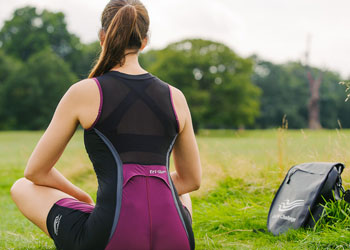 Let’s talk about being prepared for triathlon: what you eat; what you wear; and how you train. I know it feels like a lot in one blog, and a bit rich coming from a novice triathlete! But as the triathlon season really gets underway this month, these are the things that I wish I had known earlier…
Let’s talk about being prepared for triathlon: what you eat; what you wear; and how you train. I know it feels like a lot in one blog, and a bit rich coming from a novice triathlete! But as the triathlon season really gets underway this month, these are the things that I wish I had known earlier…
Get a triathlon kit. It is not arrogant or showy-offy to get a triathlon kit. Good kit makes triathlon a little bit easier for you – and therefore more fun! I was sceptical but am now a convert. You don’t need to spend hundreds of pounds, either. Here are my top 3 tips for triathlon kit that have made a huge difference to me in training:
- I bought Look Keo pedals and some road racing shoes for the bike. They made such a difference. I had been riding in trainers with cages for so long; I thought I was doing OK. But what a leap forward in power! I kept up with the men for the first time ever. I wish I had bought them sooner. And I didn’t fall off at any junctions, which apart from looking silly, was my main worry!
- My gorgeous Trigirl tri suit – oh so, so comfy. Both under the wetsuit and whilst cycling and running. No more pulling my run top down over my bum. No uncomfortable pads between the legs. No tummy squashed by too-tight shorts. Another revelation. Once you get over feeling a bit of a tri-fraud it is a joy to wear – it really is worth investing in.
- Wetsuit hire can cost around £35 per race. I’m doing two races so far this year, so I bought a £99 Orca wetsuit online. I’m 5’11’ and it fits great, works well (tested in a 13 degree lake in Essex) and psychologically – it’s mine. It boosts my confidence and removes another layer of stress.
Improve your diet. You might well need a tonne more food than you’ve been eating. I took some nutritional advice and discovered I’m often around 1,000 calories short on training days. That’s a lot of wine (just kidding! A-hem…). I was a relatively healthy, simple bowl of porridge, banana snack and chicken and avocado sandwich kind of eater. Just not enough – who knew?! Jo Scott-Dalgleish, a sports nutritionist knew. Visit her at endurancesportsnutritionist.co.uk or follow her at @jsdnutrition. My personal top tips are:
- You need protein for muscle power and for recovery, not the fabled huge bowls of pre-race pasta carbs. If you can’t face a full breakfast before training try some crunchy peanut butter on apple slices, or grab a protein-filled Nakd bar.
- If you are doing a sprint triathlon you won’t need to worry about gel packs and on-bike munchies. Jo advises a good energy drink early on in the cycle, to refuel you for the run. Tried it this weekend – worked a treat. Hurrah!
- The difference in energy when training, especially on a two-sports-training-day (which I only manage once a week) was immense when I had fuelled my day properly, from start to finish. Instead of a bowl of porridge, it became a large bowl of porridge with a big handful of flaked almonds on top. Little changes really add up over the course of a day’s eating.
Get some training. It has a big impact on your ability – but most importantly it significantly boosts your confidence. Probably my biggest ‘I wish I had done it sooner’ advice. My top 3 tips are:
- Go on a triathlon-specific training day. My Trigirl training day was a revelation! It was so encouraging meeting other like-minded (and like-terrified) women. Some experts with great stories, some novices as nervous as me. And Kristin, our trainer, shared top tips and advice: yes, wear socks, but no not cotton; scoop water into your wetsuit as you exit (helps to get out of it); and put your helmet on before even touching your bike. We learned about cadence, pace rates, you name it! Sign up for the full fabulous experience.
- General swim/bike/run training. Whichever is your weakest sport – take a few lessons from a coach. I had swim lessons at the local pool. (Read my earlier blog Spring forward and you’ll find out why!). It really does help – and you’ll find at least one other person who signed up for a triathlon and then panicked about at least one sport, too!
- Don’t put off your lake practice. Swim coaching in a lake is the single best thing I have done and should have done months ago, instead of avoiding it. I took a beginner coaching class, alongside experienced pool swimmers, who were glad they joined the coaching class too. As a weak swimmer, this was inevitable and essential for me. (And it really wasn’t that bad). The tips were great: slow your arms down, slow your breathing down and don’t panic!
So, these are my top three tips for nutrition, kit and training. I hope they help you a little. Do share your own top tips please – I still need all the help I can get!
And please come back soon to find out how THE DIRTY COLD LAKE SWIM went.
Comments are closed.